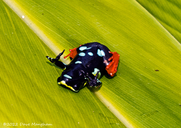|
Description
Mantella baroni is a small frog, with adults measuring 22-30 mm in snout-vent length. The head, dorsum, and flanks are solid black. A yellowish rostral stripe is apparent, generally ending past the eye. The front limb and femur are yellow to greenish in appearance, with this coloration continuing up the flanks into a large, rounded flank blotch. These flank blotches will sometimes expand dorsally across the back and connect to the opposite side blotch, resulting in a more yellow dorsum (this is most often seen in M. baroni from the Andringitra region). Hindlimbs (tibia, tarsus, and foot) are orange with irregular black stripes. There are no flashmarks on the lower hindlimbs, in contrast to those of M. madagascariensis. The venter, throat, and limbs are black and marked with a few yellow to greenish, rarely blue blotches. The throat has one circular marking, but may be all black. The iris is black (Glaw and Vences 2007).
Distribution and Habitat
Country distribution from AmphibiaWeb's database: Madagascar
This species is found only in east-central Madagascar, from Fierenana south to Andringitra, at an elevation of 600-1,200m (IUCN 2008). Mantella baroni occupies a number of habitats including swamp forests, semi-arid streambeds, bamboo groves, and streamside forests (Andriantsiferana et al. 2006) In the rainforest it is often found close to rivers and streams (Goodman and Benstead 2003; Glaw and Vences 2007), but it has also been found in slash-and-burn areas away from rainforest (IUCN 2008).Life History, Abundance, Activity, and Special Behaviors
Male M. baroni emit an intense sequence of short, single-click notes, calling during the day from refuges under grass, bushes, and rocks (Glaw and Vences 2007). Mantelline frogs lack amplexus (Glaw and Vences 2007). Females lay eggs on land (Clark et al. 2005). The eggs are unpigmented and always found close to water (Clark et al. 2005). Females can lay up to 130 eggs in one clutch (Clark et al. 2005). When the eggs develop into tadpoles, the tadpoles are washed away by rain into a nearby body of water (Goodman and Benstead 2003).
Mantella baroni is an active diurnal forager (Clark et al. 2005). It consumes a greater number of prey, as well as larger prey, than do other species of Mantella (Clark et al. 2006). Adult M. baroni consume various arthropods, with ants contributing the largest percentage of the diet (Odierna et al. 2001). Ingestion of ants, beetles, and mites creates high alkaloid concentrations in the frog’s skin, making it toxic to predators (Odierna et al. 2001). Although ants are the primary prey, the majority of toxins come from mites (Daly et al. 2007). The bright colors of M. baroni are thus aposematic and serve as a warning sign of their toxicity (Clark et al. 2005). The mechanism that the frog uses to sequester these alkaloids is unknown (Clark et al. 2005). Alkaloid composition can vary both temporally and geographically in this species (Daly et al. 2007; Clark et al. 2006).
Trends and Threats
Mantella baroni is listed as a species of “least concern” because it occupies a sizeable range, is tolerant to habitat change, and is thought to be present in high population densities. It occurs in several protected areas, including three national parks (Ranomafana, Mantadia and Andringitra, and the Pic Ivohibe Special Reserve (IUCN 2008).
Possible reasons for amphibian decline General habitat alteration and loss
Habitat modification from deforestation, or logging related activities
Intentional mortality (over-harvesting, pet trade or collecting)
Comments
Mantella baroni was first described by Boulenger (1888). It is a member of the M. cowani species group (Goodman and Benstead 2003). There is a report of hybridization with M. cowani in the wild, at a locality near Antoetra (Andreone et al. 2005).
References
Andriantsiferana, M., Andriamaharavo, N. R., Razafindrabe, C. R., Harisoa, C., Rasendra, P., Garraffo, M., Spande, T., and Daly, J. (2006). New lipophilic alkaloids from Mantella frogs collected in Madagascar. 11th NAPRECA Symposium Book of Proceedings, Antananarivo, Madagascar.
Boulenger, G. A. (1888). ''Descriptions of new reptiles and batrachians from Madagascar.'' Annals and Magazine of Natural History, series 6, 1, 101-107.
Clark, V. C., Rakotomalala, V., Ramilijaona, O., Abrell, L., and Fisher, B. L. (2006). ''Individual variation in alkaloid content of poison frogs of Madagascar (Mantella; Mantellidae).'' Journal of Chemical Ecology, 32, 2219-2233.
Clark, V. C., Raxworthy, C. J., Rakotomalala, V., Sierwald, P., and Fisher, B. L. (2005). ''Convergent evolution of chemical defense in poison frogs and arthropod prey between Madagascar and the Neotropics.'' Proceedings of the National Academy of Sciences, 102(33), 11617-11622.
Daly, J. W., Garraffo, M., Spande, T. F., Giddings, L., Saporito, R. A., Vieites, D. R., and Vences, M. (2008). ''Individual and geographic variation of skin alkaloids in three species of Madagascan poison frogs (Mantella).'' Journal of Chemical Ecology, 34, 252-279.
Glaw, F., and Vences, M. (2007). Field Guide to the Amphibians and Reptiles of Madagascar. Third Edition. Vences and Glaw Verlag, Köln.
Goodman, S. M., and Benstead, J. P. (2003). The Natural History of Madagascar. University of Chicago Press, Chicago.
IUCN (2008). 2008 IUCN Red List of Threatened Species. www.iucnredlist.org. Downloaded on 11 December 2008.
Odierna, G., Vences, M., Aprea, G., Lötters, S., and Andreone, F. (2001). ''Chromosome data for Malagasy poison frogs (Amphibia: Ranidae: Mantella) and their bearing on taxonomy and phylogeny.'' Zoological Science, 18, 505-514.
Originally submitted by: Nathan Van Patten (first posted 2008-12-17)
Edited by: Kellie Whittaker (2009-02-09)Species Account Citation: AmphibiaWeb 2009 Mantella baroni <https://amphibiaweb.org/species/4560> University of California, Berkeley, CA, USA. Accessed May 24, 2025.
Feedback or comments about this page.
Citation: AmphibiaWeb. 2025. <https://amphibiaweb.org> University of California, Berkeley, CA, USA. Accessed 24 May 2025.
AmphibiaWeb's policy on data use.
|
